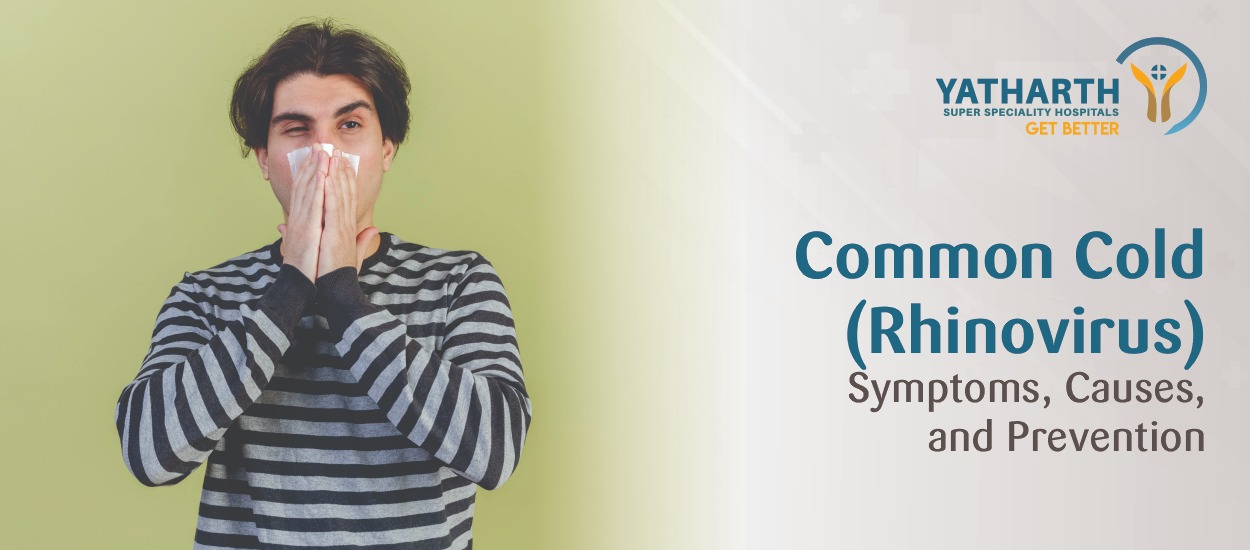The common cold, most often caused by rhinoviruses, is one of the most frequent viral infections affecting people of all ages. While generally mild, it can still disrupt daily routine with symptoms like sneezing, sore throat, cough, and congestion. Children catch colds more often than adults, but the infection can affect anyone, especially during seasonal changes.
In this blog, we cover the symptoms, causes, risk factors, diagnosis, and preventive measures for the common cold—along with helpful FAQs.
What Is the Common Cold (Rhinovirus)?
The common cold is a contagious viral infection of the upper respiratory tract, primarily involving the nose and throat. More than 200 different viruses can cause a cold, but rhinoviruses are responsible for 50–70% of cases.
The infection is usually mild and self-limiting, lasting 7–10 days, but symptoms may persist longer in individuals with weakened immune systems, allergies, or existing respiratory conditions.
Symptoms of the Common Cold
Symptoms appear 1–3 days after exposure to the virus and may vary from person to person.
1. Sneezing
One of the earliest signs caused by irritation in the nasal passages.
2. Runny or Stuffy Nose
Clear nasal discharge that may thicken and turn yellow or green as the cold progresses.
3. Sore Throat
Often mild and improves within the first 2 days.
4. Cough
Persistent cough may last even after other symptoms have resolved.
5. Headache and Body Aches
Mild headaches or muscle soreness due to viral inflammation.
6. Low-Grade Fever
More common in children than adults.
7. Watery Eyes
Tearing and eye irritation may accompany nasal symptoms.
8. Mild Fatigue
Feeling tired or weak is common during infection.
If symptoms last more than 10 days or worsen, it may indicate a bacterial infection or another condition like sinusitis or influenza.
What Causes the Common Cold?
The common cold is caused by viral infections, primarily:
1. Rhinoviruses (Most Common)
-
Thrive in the nose and upper airway
-
Spread quickly in crowded or cold environments
2. Other Cold-Causing Viruses
-
Coronaviruses (non-COVID strains)
-
Adenoviruses
-
Respiratory syncytial virus (RSV)
-
Parainfluenza viruses
How Does the Common Cold Spread?
The virus spreads easily through:
1. Airborne Droplets
Coughing, sneezing, or talking releases droplets containing the virus.
2. Direct Contact
Shaking hands or touching contaminated surfaces.
3. Touching Face
Virus enters through the nose, eyes, or mouth when a person touches their face with contaminated hands.
Risk Factors for the Common Cold
You may be more likely to catch a cold if:
-
You are a child (especially in school or daycare)
-
You have a weakened immune system
-
You live or work in crowded spaces
-
You have seasonal allergies
-
Weather changes lead to weaker immune defenses
-
You are exposed to infected individuals frequently
Complications of the Common Cold
Though usually mild, complications can occur:
-
Sinusitis
-
Ear infections (otitis media)
-
Bronchitis
-
Exacerbation of asthma or COPD
Seek medical attention if symptoms become severe or persistent.
Diagnosis of the Common Cold
Diagnosis is usually clinical based on:
1. Physical Examination
Doctor checks:
-
Nasal congestion
-
Throat redness
-
Temperature
-
Breathing sounds
2. Medical History
Includes symptom duration and exposure to infections.
3. Laboratory Tests (Rarely Needed)
Used only if symptoms suggest pneumonia, flu, or COVID-19.
Prevention of the Common Cold
While there’s no vaccine for the common cold, preventive measures can significantly reduce risk.
1. Wash Hands Frequently
Use soap and water for at least 20 seconds.
2. Avoid Touching Face
Especially nose, mouth, and eyes.
3. Strengthen Immunity
-
Balanced diet
-
Adequate sleep
-
Regular exercise
-
Hydration
4. Avoid Close Contact with Sick People
Especially in peak cold seasons.
5. Maintain Clean Surfaces
Disinfect frequently touched objects—phones, doorknobs, keyboards.
6. Use Tissue or Elbow When Sneezing/Coughing
Prevents spreading droplets.
7. Humidify Indoor Air
Helps reduce nasal irritation.
8. Wear a Mask During Outbreaks
Especially helpful in crowded areas















